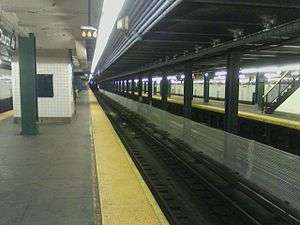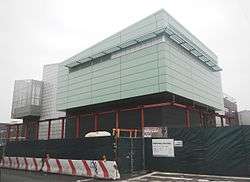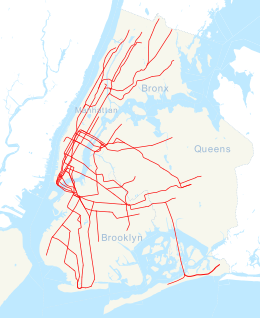Church Avenue station (IND Culver Line)
Church Avenue is an express station on the IND Culver Line of the New York City Subway. Located at Church and McDonald Avenues in Kensington, Brooklyn, it is served by the F and G trains at all times (the latter of which terminates here), and by the <F> train during rush hours in the peak direction.
Church Avenue | |||||||||||
|---|---|---|---|---|---|---|---|---|---|---|---|
 Platform view | |||||||||||
| Station statistics | |||||||||||
| Address | Church Avenue & McDonald Avenue Brooklyn, NY 11218 | ||||||||||
| Borough | Brooklyn | ||||||||||
| Locale | Kensington | ||||||||||
| Coordinates | 40°38′34″N 73°58′46″W | ||||||||||
| Division | B (IND) | ||||||||||
| Line | IND Culver Line | ||||||||||
| Services | F G | ||||||||||
| Transit connections | |||||||||||
| Structure | Underground | ||||||||||
| Platforms | 2 island platforms cross-platform interchange | ||||||||||
| Tracks | 4 | ||||||||||
| Other information | |||||||||||
| Opened | October 7, 1933 | ||||||||||
| Station code | 243[1] | ||||||||||
| Accessible | |||||||||||
| Wireless service | |||||||||||
| Opposite-direction transfer available | Yes | ||||||||||
| Traffic | |||||||||||
| Passengers (2019) | 3,051,736[3] | ||||||||||
| Rank | 166 out of 424[3] | ||||||||||
| Station succession | |||||||||||
| Next north | Seventh Avenue (express): <F> Fort Hamilton Parkway (local): F | ||||||||||
| Next | Queens Plaza (via Crosstown): no regular service Jay Street–MetroTech (via Culver): F | ||||||||||
| Next south | (Terminal): G Ditmas Avenue (local): F 18th Avenue (express): no regular service | ||||||||||
| Next | Coney Island–Stillwell Avenue: F | ||||||||||
| |||||||||||
| |||||||||||
| |||||||||||
The Church Avenue station was constructed by the Independent Subway System (IND). It opened on October 7, 1933, as the new terminal of the Culver Line, which was known as the Smith Street Line or the South Brooklyn Line at the time. In 1954, this station ceased to be the line's terminal with the completion of the Culver Ramp, which connected the South Brooklyn Line and the Brooklyn–Manhattan Transit Corporation (BMT)'s Culver Line and allowing service to run to Coney Island. Though the Church Avenue station contains four tracks and two island platforms, as with most express stations in the New York City Subway, the inner tracks see limited use, being used only by peak-direction <F> trains.
History
The Church Avenue station was the original southern terminus of the IND Culver Line, which was built as part of Mayor John Hylan's Independent Subway System (IND) to Coney Island. The line was planned to be extended to the south via a connection to the Brooklyn–Manhattan Transit Corporation (BMT)'s Culver Line.[4][5] To connect this line to the Eighth Avenue Line – the main trunk of the IND – a subway line was to run from Brooklyn Borough Hall south under Jay Street, Smith Street, Ninth Street, and several other streets to Cortelyou Road (later Church Avenue) and McDonald Avenue, just north of the Ditmas Avenue elevated station. A ramp would then lead onto the elevated BMT Culver Line.[4][5][6] As originally designed, service to and from Manhattan would have been exclusively provided by Culver express trains, while all local service would have fed into the IND Crosstown Line.[7] On October 7, 1933, this station opened as the new terminal of the line, as the line was extended from Bergen Street.[8][9]
.jpg)
Construction on the Culver Ramp, also referred to as the Culver Line Connection, between this station and the Ditmas Avenue station, began in June 1941 and was scheduled to be completed by the end of the year.[10] The ramp was expected to cost $2 million, and along with new signals, and rehabilitation of the Culver elevated and lengthening of its stations to IND standards, the total cost of the project was estimated at over $11 million.[11][12][13] Though the ramp was nearly complete, including rails and signal work, construction was halted later that year because of America's entrance into World War II.[13][14][15] When the project was restarted in 1946, completion was delayed further due to continued material shortages and a lack of rolling stock to facilitate the new service.[16] On October 30, 1954,[17] the connection between the IND Brooklyn Line at Church Avenue and the BMT Culver Line at Ditmas Avenue opened, allowing IND trains to operate all the way to the Coney Island–Stillwell Avenue terminal.[18]
In 1958, there was a program in which subway riders could get their clothes dry cleaned at the station for a fee.[19]
Service changes
The station was originally served by the A train. In 1936, the A was rerouted to the IND Fulton Street Line and was replaced by E trains from the Queens Boulevard Line.[8] In 1937, the connection to the IND Crosstown Line opened and GG (later renamed the G) trains were extended to Church Avenue, complementing the E. In December 1940, after the IND Sixth Avenue Line opened, E trains were replaced by the F, and the GG was cut back to Smith–Ninth Streets.[8] Following the completion of the Culver Ramp in 1954,[20][21] D Concourse Express trains replaced F service to Coney Island.[21][13] In November 1967, the Chrystie Street Connection opened and D trains were rerouted via the Manhattan Bridge and the BMT Brighton Line to Coney Island. F trains were extended once again via the Culver Line.[13][22]
The center tracks at the station were used for F express service starting in June 1968,[23] while G trains were extended from Smith–Ninth Streets to Church Avenue to provide local service.[24][7] Express service between Bergen and Church ended in 1976 due to budgetary concerns and passenger complaints, and the GG, later renamed the G, was again terminated at the Smith–Ninth Streets station.[24][7][25]
In July 2009, the G was extended from its long-time terminus at Smith–Ninth Streets to a more efficient terminus at Church Avenue to accommodate the rehabilitation of the Culver Viaduct.[24][26] The G extension was made permanent in July 2012.[27] In July 2019, the MTA revealed plans to restore express service on the Culver Line between Jay Street and Church Avenue. Express service started on September 16, 2019.[28][29]
Incidents
On December 28, 1949, 1936 Olympic gold medalist from New Zealand Jack Lovelock fell onto the tracks at the Church Avenue station after complaining to his wife about dizziness; he was then killed by an oncoming train.[30] On August 2, 1974, a robbery suspect was killed by a plainclothes police officer in the station. The former was suspected to have robbed a token booth in the station shortly beforehand.[31]
Station layout
| G | Street level | Exit/entrance |
| M | Mezzanine | Fare control, station agent |
| P Platform level |
Northbound local | ← ← |
| Island platform | ||
| Northbound express | ← | |
| Southbound express | (No service: 18th Avenue) | |
| Island platform | ||
| Southbound local | | |
Track layout | ||||||||||||||||||||||||||||||||||||||||||||||||||||||||||||||||||||||||||||||||||||||||||||||||||||||||||||||||||||||||||||||||||||||||||||
|---|---|---|---|---|---|---|---|---|---|---|---|---|---|---|---|---|---|---|---|---|---|---|---|---|---|---|---|---|---|---|---|---|---|---|---|---|---|---|---|---|---|---|---|---|---|---|---|---|---|---|---|---|---|---|---|---|---|---|---|---|---|---|---|---|---|---|---|---|---|---|---|---|---|---|---|---|---|---|---|---|---|---|---|---|---|---|---|---|---|---|---|---|---|---|---|---|---|---|---|---|---|---|---|---|---|---|---|---|---|---|---|---|---|---|---|---|---|---|---|---|---|---|---|---|---|---|---|---|---|---|---|---|---|---|---|---|---|---|---|---|
| ||||||||||||||||||||||||||||||||||||||||||||||||||||||||||||||||||||||||||||||||||||||||||||||||||||||||||||||||||||||||||||||||||||||||||||
This underground station, located in Kensington,[33] has four tracks and two island platforms.[34] Both outer track walls have a maroon trim line with a Tuscan red border and small signs below them reading "CHURCH" in white lettering on a black background. This tile band is set in a two-tile-high course, an arrangement normally seen at local stations.[35] All I-beam columns in the station are colored Hunter green. The station signs are in the standard black name plates with white lettering.[36]
There is a four-track train storage yard known as Church Avenue Yard south of the station beneath the revenue tracks, which is used by terminating G trains.[37][38] South of the connection to the yard, the line ramps up to become a three-track elevated line (with the express tracks merging into one track, with switches from the express to the local tracks in the respective directions) before entering Ditmas Avenue station. Though this station is a part of the IND Division, the Culver elevated portion directly to the south of this station is controlled by BMT radio dispatch and supervision, so train operators change between the IND (B-2) and BMT (B-1) radio frequencies at this point or station.[34]
During off-peak hours, the express tracks can be used for staging subway cars without interfering with normal service.[38]
Exits

This station has a full length mezzanine above the platforms and tracks with two fare control areas. The full-time one is at the extreme south end. Two staircases and one elevator from each platform go up to the mezzanine, where public restrooms at the center are available and a turnstile bank provides entrance/exit to/from the station. Outside fare control, there is a token booth and staircases going up to all four corners of Church and McDonald Avenues.[33] There is also a ramp leading to an elevator that goes up to the west side of Church Avenue. The three elevators, installed during a 2008 renovation, make the station ADA accessible.[39]
The station's other fare control area at the north end is un-staffed. Three staircases from each platform go up to a mezzanine, where exit-only and High Entry/Exit Turnstiles provide entrance/exit to/from the station. Outside fare control, there are two staircases facing in different directions that go up to either southern corners of Albemarle Road and McDonald Avenues. Crew facilities at the center of the mezzanine separate the two fare control areas.[33]
References
- "Station Developers' Information". Metropolitan Transportation Authority. Retrieved June 13, 2017.
- "NYC Subway Wireless – Active Stations". Transit Wireless Wifi. Retrieved November 13, 2019.
- "Facts and Figures: Annual Subway Ridership 2014–2019". Metropolitan Transportation Authority. 2020. Retrieved May 26, 2020.
- "Plan to Recapture Culver Line Ready" (PDF). The New York Times. July 12, 1932. p. 9. ISSN 0362-4331. Retrieved March 27, 2020.
- "New Subway Routes in Hylan Program to Cost $186,046,000" (PDF). The New York Times. March 21, 1925. p. 1. ISSN 0362-4331. Retrieved March 27, 2020.
- Duffus, R.L. (September 22, 1929). "Our Great Subway Network Spreads Wider" (PDF). The New York Times. ISSN 0362-4331. Retrieved August 19, 2015.
- Feasibility and Analysis of F Express Service in Brooklyn (PDF). Metropolitan Transportation Authority (Report). May 2016. Archived (PDF) from the original on May 27, 2016. Retrieved June 24, 2016.
- "Independent Subway Services Beginning in 1932". thejoekorner.com. August 21, 2013. Archived from the original on November 22, 2019. Retrieved August 2, 2015.
Information adapted from:- New York Division Bulletin (Report) (October and November 1968 ed.). Electric Railroaders’ Association, Inc. Fall 1968.
- "City Subway Extended" (PDF). The New York Times. October 7, 1933. p. 16. ISSN 0362-4331. Retrieved December 18, 2018.
- "Vogel Lauds City for Speed In Starting Culver 'L' Link". Brooklyn Daily Eagle. June 10, 1941. Retrieved September 15, 2015 – via Newspapers.com

- Schmalacker, Joseph H. (January 3, 1941). "Culver Link to City Subway To Relieve 4 Other Lines: Will Permit More Trains to Run On Coney, 4th Ave. Branches". Brooklyn Daily Eagle. p. 3. Retrieved September 15, 2015 – via Newspapers.com

- Schmalacker, Joseph H. (January 2, 1941). "New One-Fare Link to Coney Imminent: Transportation Board to Seek Bids For Culver Ramp to Independent Line". Brooklyn Daily Eagle. pp. 1, 5. Retrieved September 15, 2015 – via Newspapers.com

- Sparberg, Andrew J. (October 1, 2014). From a Nickel to a Token: The Journey from Board of Transportation to MTA. Fordham University Press. ISBN 978-0-8232-6190-1.
- Blauvelt, Paul (June 9, 1946). "Shortages Snarl $50,000,000 Tube Links". Brooklyn Daily Eagle. p. 21. Retrieved October 9, 2015 – via Newspapers.com

- "200 City Projects Face Standstill Due to Priorities" (PDF). The New York Times. August 18, 1941. p. 1. ISSN 0362-4331. Retrieved May 27, 2019.
- Jaffe, Alfred (December 6, 1946). "Borough Subway Relief Still 2 or 3 Years Off". Brooklyn Daily Eagle. pp. 1, 5. Retrieved October 9, 2015 – via Newspapers.com

- Chiasson, George (May 2010). "A History of the F (and V) Train Service". New York Division Bulletin. Electric Railroaders' Association. 53 (5): 1, 4.
- "Adequate Transit Promised for City". The New York Times. October 29, 1954. p. 25. ISSN 0362-4331. Retrieved May 27, 2019.
- "IND Riders To Get Cleaning Service". The New York Times. July 2, 1958. ISSN 0362-4331. Retrieved July 15, 2016.
- "NYCTA- Pass for Culver Line Ceremonies - 1954". flickr.com. New York City Transit Authority. 1954. Retrieved August 14, 2016.
- "Adequate Transit Promised For City" (PDF). The New York Times. October 29, 1954. p. 25. ISSN 0362-4331. Retrieved April 23, 2018.
- Perlmutter, Emanuel (November 16, 1967). "Subway Changes To Speed Service" (PDF). The New York Times. ISSN 0362-4331. Retrieved April 23, 2018.
- "'F' Line Rush-Hour Service Will Be Added in Brooklyn" (PDF). The New York Times. June 8, 1969. ISSN 0362-4331. Retrieved August 26, 2016.
- Review of F Line Operations, Ridership, and Infrastructure (PDF). nysenate.gov (Report). MTA New York City Transit Authority. October 7, 2009. Archived from the original (PDF) on May 31, 2010. Retrieved July 28, 2015.
- Geberer, Raanan (March 6, 2013). "Light at End of Tunnel: F Train Express may return". Brooklyn Daily Eagle. Archived from the original on March 27, 2020. Retrieved July 28, 2015.
- Review of the G Line (PDF). mta.info (Report). Metropolitan Transportation Authority. July 10, 2013. Archived from the original (PDF) on December 24, 2019. Retrieved August 2, 2015.
- Flegenheimer, Matt (July 19, 2012). "M.T.A. Subway, Train and Bus Services to be Restored". The New York Times. ISSN 0362-4331. Retrieved April 23, 2018.
- Barone, Vincent (July 9, 2019). "Limited F express service coming to Brooklyn for rush hour". AMNY. Archived from the original on October 3, 2019. Retrieved July 9, 2019.
- "MTA NYC Transit Adding Limited F Express Service for Brooklyn Residents with Longest Commutes" (Press release). New York City Transit. July 10, 2019. Archived from the original on September 14, 2019. Retrieved July 10, 2019.
- Wallechinsky, D. (2004). The Complete Book of the Summer Olympics: Athens 2004. Complete Book of the Olympics. Sport Media Pub. p. 251. ISBN 978-1-894963-32-9. Retrieved August 8, 2018.
- "Suspect Killed in IND Station Holdup". The New York Times. August 2, 1974. ISSN 0362-4331. Retrieved July 15, 2016.
- One AM rush hour F train terminates and originates at this station.
- "Church Avenue Neighborhood Maps" (PDF). mta.info. Metropolitan Transportation Authority. September 2018. Retrieved May 27, 2019.
- Dougherty, Peter (2006) [2002]. Tracks of the New York City Subway 2006 (3rd ed.). Dougherty. OCLC 49777633 – via Google Books.
- Cox, Jeremiah (June 9, 2009). "Even through the platforms were renovated at Church Avenue, the station wall trim wasn't, there the same with some tiles missing". subwaynut.com. Retrieved May 27, 2019.
- Cox, Jeremiah (June 6, 2007). "Looking down one of the platforms at Church Avenue by a garbage train parked on the express track". subwaynut.com. Retrieved May 27, 2019.
- "Church Avenue Subway Yard". ltvsquad.com. LTV Squad. November 23, 2015. Retrieved November 23, 2015.
- "Hollywood Underground: The Art of Making Movies in The New York City Subway". Metropolitan Transportation Authority. Retrieved August 16, 2015.
- "MTA NYC Transit Opens ADA Elevators at Church Avenue F Station in Brooklyn". mta.info. Metropolitan Transportation Authority. July 7, 2008. Retrieved July 9, 2008.
External links
| Wikimedia Commons has media related to Church Avenue (IND Culver Line). |
- nycsubway.org – IND Crosstown: Church Avenue
- Station Reporter — F Train
- The Subway Nut — Church Avenue – Kensington Pictures
- Church Avenue entrance from Google Maps Street View
- Albemarle Road entrance from Google Maps Street View
- Mezzanine from Google Maps Street View
- Platforms from Google Maps Street View
- Joseph Brennan, "Abandoned Stations"



%26groups%3D_3e55983e4724fdf49b24f893e7894c4526e94a8a.svg)